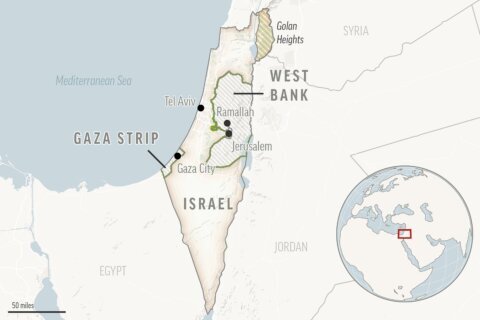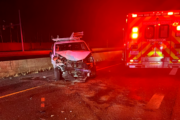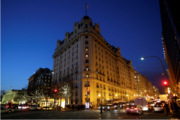DEATH VALLEY, Calif. (AP) — Hundreds of Europeans touring the American West and adventurers from around the U.S. are still being drawn to Death Valley National Park, even though the desolate region known as one of the Earth’s hottest places is being punished by a dangerous heat wave blamed for a motorcyclist’s death over the weekend.
French, Spanish, English and Swiss tourists left their air-conditioned rental cars this week to take photographs of the barren landscape so different than the snow-capped mountains and rolling green hills they know back home. American adventurers liked the novelty of it, even as officials at the park in California warned visitors to stay safe.
“I was excited it was going to be this hot,” said Drew Belt, a resident of Tupelo, Mississippi, who wanted to stop in Death Valley as the place boasting the lowest elevation in the U.S. on his way to climb California’s Mount Whitney. “It’s a once-in-a-lifetime opportunity. Kind of like walking on Mars.”
The searing heat wave gripping large parts of the U.S. also led to record daily high temperatures in Oregon, where it is suspected to have caused six deaths, the state medical examiner’s office said Tuesday. More than 161 million people around the U.S. were under heat alerts, especially in Western states.
Dozens of locations in the West and Pacific Northwest tied or broke previous heat records over the weekend and are expected to keep doing this week.
At Death Valley National Park, tourists queued for photos in front of a giant thermometer the National Park Service keeps near the visitor center. It’s not precise, registering the temperature anywhere from 1 to 5 degrees Fahrenheit higher than more modern instruments kept by the National Weather Service nearby, providing a more impressive reading for pictures.
““It’s not cited to be an official temperature sensor,” said Dan Berc, a warning coordination meteorologist for the National Weather Service in Las Vegas.
“This is an incredibly popular place to be, as you can see from the visitors behind me,” supervisory park ranger Jeanette Jurado said Tuesday by the thermometer, which read 120 F (48.9 C). “But even in the wintertime, people might find that 80 degrees in December is unusual and worthy of taking a picture.”
An excessive heat warning was also in place for much of Washington and Oregon on Tuesday, with the potential for temperatures to reach up to 110 F (43.3 C) in areas, posing a major risk for heat-related illness, the National Weather Service said. Temperatures in parts of Idaho, including Boise, were expected to reach over 100 F (37.7 C) on Tuesday.
The early U.S. heat wave came as the global temperature in June was record warm for the 13th straight month and marked the 12th straight month that the world was 1.5 degrees Celsius (2.7 degrees Fahrenheit) warmer than pre-industrial times, the European climate service Copernicus said. Most of this heat, trapped by human-caused climate change, is from long-term warming from greenhouse gases emitted by the burning of coal, oil and natural gas, scientists say.
In eastern California’s sizzling desert, a high of 128 F (53.3 C) was recorded over the weekend at Death Valley National Park, where a visitor, who was not identified, died Saturday from heat exposure. Another person was hospitalized.
They were among six motorcyclists riding through the Badwater Basin area in scorching weather, the park said in a statement. The other four were treated at the scene. Emergency medical helicopters were unable to respond because the aircraft cannot generally fly safely over 120 F (48.8 C), officials said.
Death Valley is considered one of the most extreme environments in the world. The hottest temperature ever officially recorded on Earth was 134 F (56.67 C) in July 1913 in Death Valley, though some experts dispute that measurement and say the real record was 130 F (54.4 C), recorded there in July 2021.
“It’s impressive,” Thomas Mrzliek, of Basel, Switzerland, said of the triple-digit heat. “It like a wave that hits when you get out of the car, but it’s a very dry heat. So it’s not as in Europe.”
Across the desert in Nevada, Las Vegas already had hit 103 F (39.4 C) by 9:30 a.m. Tuesday and was likely to approach 120 F (48.8 C) again by day’s end.
“Intense heatwave will continue to set records through the end of the week before moderating as increasing monsoonal moisture returns to the area,” the National Weather Service in Las Vegas said.
In Arizona, the average temperatures for the first eight days of July have been the hottest on record for Phoenix and Yuma, said the National Weather Service in Phoenix. It said both cities will remain at about 10 degrees above normal over the next few days, with highs mostly between 112 F (44.4 C) and 120 F (48.8 C).
Extreme heat and a longstanding drought in the West has also dried out vegetation that fuels wildfires.
In California, firefighters were battling least 18 wildfires Tuesday, including a 41-square-mile (106-square-kilometer) blaze in the mountains of Santa Barbara County. The Lake Fire was only 12% contained, and forecasters warned of a “volatile combination” of high heat, low humidity and northwest winds developing late in the day.
North of Los Angeles, the 2-square-mile (5-square-kilometer) Vista Fire chewed through trees in the San Bernardino National Forest and sent up a huge plume of smoke visible across the region. A small but smoky blaze, dubbed the Royal Fire, burned through more than 150 acres (60 hectares) of forest west of Lake Tahoe and sent ash raining down on the tourist town of Truckee, California. Neither fire was contained Tuesday.
The National Weather Service said Tuesday it was extending the excessive heat warnings across most of the Southwest U.S. through Saturday morning.
“Unusually high temperatures are now projected to linger through Friday, and then with increased cloud cover Saturday morning`s lows may be the warmest of this entire episode,” the service in Reno said. “Thursday could end up being the hottest overall day for most locations, so it’s not over yet.”
___
Snow reported from Phoenix. AP journalists Becky Bohrer in Juneau, Alaska; Christopher Weber and John Antczak in Los Angeles; and Scott Sonner and Gabe Stern in Reno, Nevada, contributed to this report.
Copyright © 2024 The Associated Press. All rights reserved. This material may not be published, broadcast, written or redistributed.







